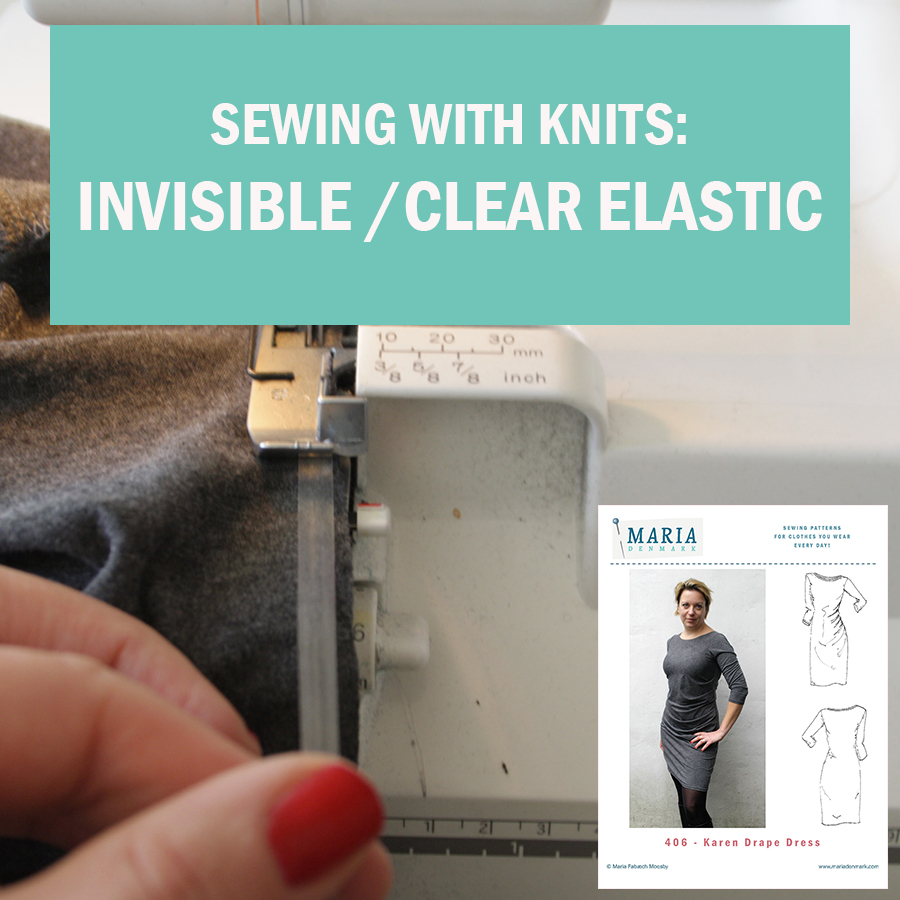Invisible (or clear) elastic is one of our overlooked (tee hee) helpers when it comes to sewing jersey fabric. At least, in my experience, most of my students don’t know of the many uses for it.
One of the great ways to use invisible elastic, is to use it for stabilizing a neckline (or, indeed, armholes) you want to just fold over and stitch from the right side, to keep the neckline from stretching out of shape and ultimately gaping.
How to use invisible elastic as a stabilizer:
In this video, I show you how to stabelize the neckline of the Karen Drape Dress. But you use the same method for the back neckline and the armholes on the Day-2-Night Drape Top – and you can even use it for the FREE Kirsten Kimono Tee, you get when you sign up for my newsletter.
What is invisible elastic?
Invisible (or clear) elastic is, as the name implies, transparent elastic. It’s not actually invisible – that would be weird. But because it is see through and rather thin, you can use it with thin fabric without it showing on the right side. It’s often made from silicone or elastane.
It’s widely available in most fabric stores I know, but just so you know what we are talking about, here are a few links:
Prym Clear Elastic (UK)
Dritz clear elastic (Amazon)
How to use the invisible/clear elastic:
Use the elastic to stabilize for instance a boat neck neckline, before you fold the seam allowances under and stitch the neckline from the right side.
- Leave the elastic on the roll, but un-roll the amount you need (about 80 cm / just under a yard). Pre stretch the elastic a few times.
- Pin one end of the elastic to the wrong side of the neckline seam allowance with a single pin – just to keep it in place when you start sewing. I always leave an extra 10 cm /4″ on the other side of the presser foot, to hold on to when the sewing begins (just trim it off afterwards). I always begin the sewing at centre back, but that’s a personal preference.
- Sew the elastic to the wrong side of the seam allowance. Use a serger (overlocker) or a stretch stitch on your sewing machine. Hold the elastic taut while sewing, but do not stretch it.
- Sew all way around, and let the elastic overlap a bit before stopping. Trim the elastic ends.
- Fold the seam allowances under and pin it in place. Stitch from the right side using a stretch stitch on your sewing machine.
- Final (but very important) step is to steam press the neckline pretty and flat. If your fabric is delicate, simply hold teh iron over it and steam, and then press down with your hand while the fabric cools. I always use a pressing ham to maintain the curve of teh neckline.




Great tip! Thank you Maria. I’m never sure what is the best way to finish necklines on jersey dresses so I will definitely be tryin this.
You ate a clown for breakfast I guess :-D. What a funny post ;-)
One question: you sew twice from the middle to the end, right? Not in one way? I saw this before but forget it everytime *gnagna*
Thanks for the hint with the elastic, will try it next time!
Good tip, but you left a step out in your written instructions. After applying the elastic you forgot the step of topstitching
Fold, then top-stitch between step 4 and 5?
Sandy – you are absolutely right. Sorry! And thank you! :-)
Thank you! This is a really helpful tutorial that I will most certainly try out, soon.
Silly question, but where can you actually purchase this clear elastic? I am in the UK and have never seen it anywhere! I have asked the owner of my local haberdashery shop who is usually really knowledgeable and she had never heard of it and was suggesting it might be “an American thing”. Hence I tried on ebay, but all I can find is elastic cord which is used for jewellery making. If you could enlighten me of the official name for it, or some sources online where I might find it, I’d really appreciate it! :)
Mel, there is a link in the post to a UK shop (Jaycotts) that has it http://www.jaycotts.co.uk/products/prym_910700#.Vpyj2SrhA8R
Hi, John Lewis sell narrow clear elastic too :-)
What a great tip, I can’t wait to try it Maria, thanks for sharing!
This is an excellent solution to the “do I face/do I turn under” dilemma. However, I wonder how long the elastic will retain its stretch, since I keep and wear my clothing for years.
In my experience the stretch lasts as long as the garment. I haven’t had any issues with it, anyway. :-)
Good tip, thanks!
I can’t see if you put the needle through the elastic or not. Wouldn’t it cause the elastic to tear if you’d put the needle through?
Hi Esther. I sew right through the elastic – and the elastic doesn’t tear. So no worries :-)
I’ve had problems with the elastic edge flipping out – any advice for that problem? I love my drape top (day to night) but the armhole edge definitely has this issue.
I have a question. Will this also work on hems? Sweater knits stretch out of shape like crazy and I was wondering if this would do the trick when hemming this kind of fabric.
Hi,
Sorry but i am confused about one aspect. When using facing on a curved neckline i always notch the seam allowance to allow the curve to shape smoothly (same idea with a kimono sleeve at the armpit area. How would you do with this tape? Would you notch it in narrow curves? Or doing some kind of overlapping with multiple short pieces?
You don’t need to notch knits, the stretch allows them to lay flat without it. So it wouldn’t be a problem. And for wovens, which do need to be notched, you don’t need to stabilise with elastic.
I am working on a dress that called for facings and a more curved v-like neckline in the cleavage area. I ended up with a slinky knit fabric because I needed a 54″ width. I have never sewn on knit! LOL! So I remembered a serger that was in the closet (and I have never serged!…suddenly its a big adventure. I used the elastic tape on the shoulder seams with the serger and I believe that will be OK but am confounded by the neckline whether I will be forced into a conventional machine or if I can use the serger without facings but instead elastic tape. Its the Burda dress with shirring & pockets.They give very scant instructions…
I did go purchase cheap knit and cut out the neck facings and neckline for practice. I wish I knew if serging can work on this shape of neckline because the regular machine even with proper needles will require tissue paper or something just to sew this.
I am not familiar with the pattern you are sewing, but I rarely like a facing on a knit dress – and never on a slinky knit! However, if you are sewing a facing, use the sewing machine for sewing that.
Instead, I would recommend, that you cut and sew a ribbing or binding made from the fabric.
https://www.mariadenmark.com/2014/10/qa-sewing-with-knits/ (ribbing and includes a video that shows you how to) and https://www.mariadenmark.com/2017/02/knit-top-binding/ (binding)
Thank You so much. It appears that I am going to learn a lot about knits!
Can this clear elastic be used on facemasks for fastening around the ears? will it withstand hot water or the heat of a dryer. I am making medical facemasks & this clear elastic was given to me to use. Cannot find 1/4 regular elastic anywhere.
thank you Maria! It’s been a long time since I’ve sewn knit fabrics and found out about clear elastic for necklines online. Your video explained how to use it perfectly and your touch of humor was a plus!